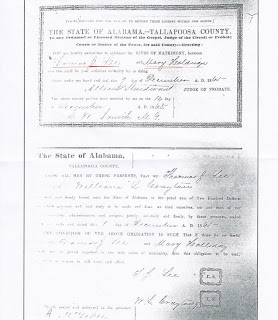Online Family Trees as Proof
There is nothing, in genealogical research, more frustrating than to search for an ancestor and then the search result comes up and the source is an online family tree. Then to top that off there are numerous family trees with the same information in their tree with no sources to back up the information. I have found while looking through my DNA match list the same method is used in those family trees when there is a tree available. Recently I had a match on my Burnett line and was excited to see that match. When I looked at the family tree it was exactly like all the other family trees online. A very frustrating discovery. Also, the DNA circles with the same information that others have in their family trees. It is a cycle that continues to be repeated. It would be a very exciting to discovery to find a match that would have one record that will link Jordan Lee to his parents, and have the probate record or any record as proof of the parentage.
There are family trees that have parents too young to have children, and children attached to parents where there is no proof of the parentage. There are family trees with people married to the incorrect spouse, and they use a marriage record of a child to prove the marriage of their parents. Also, there are some parents who have sixteen children and some with the same names. Will this trend of errors, inconsistencies or copying of trees ever end? Probably not! It is much easier to copy the information and claim it as your own than to take the time to research your ancestors and prove they are your ancestors.
One important thing that a good family historian will do is be sure that the ancestor researched is their ancestor and there is proof of it. You do that by research and proof of accuracy.
Research your ancestor and find all available records for the period in which you are researching. Make sure the information is accurate. An online family tree isn’t a record; however, those trees may be used as a guide in finding records to prove your ancestry.
When I began researching over fifteen years ago I had very little information on my Lee family. I didn’t know my grandmother’s name, other than she was Granny Eley. My sister who is ten years older than me knew she was Alice Lee married to a Jack Eley. She knew that Granny was born in Alabama. She also knew Granny’s mother’s name and where she was married. With that information I began my journey into genealogical research.
I visited Daddy’s only living sibling, Gladys, to gather information from her, only to find out she didn’t know anything other than Granddaddy Eley had a brother who lived in Rayville in Richland Parish. Which proved to be inaccurate information. The brother was Granddaddy Eley’s uncle, his father’s brother. Aunt Gladys also told me that families didn’t talk and share information. That was a disappointing visit and I wasn’t sure that my aunt was being honest with me and she didn’t want to give out information. About a year later I made another visit to see if I could get her to talk any more about our family, but that visit didn’t produce any more information. She died a few months later so all that history is gone forever. My quest continued in the search to learn about the Lee family.
I turned to online family trees and looked through the family trees that had records such as census, marriage, death, cemetery, land records, and any other records that would help prove this to be my family line. Those online family trees helped in locating records in proving the family link. This was a project that took time and energy. I carefully examined the records making sure this was my ancestor’s record. Those were the days before the mass collection of online data bases. This was during the era of courthouse trips, walking cemeteries, and going to repositories where your ancestor lived. However, the rules for using reliable and accurate information in your research are the same regardless of the period in which you are researching.
Family history research has been a journey where I have not been satisfied until I know I have exhausted all searches for information on my family lines. I have used all available resources to research family, connected with new cousins and reconnected with long ago cousins. Connecting with new cousins and reconnecting with cousins have helped in getting their family’s stories, photos, and records. They have provided valuable information for their families.
My desire is that my family tree is as accurate as any family historian can be when using the standards of research in proving their ancestry.
 |
Pleas Rodden, a farmer plowing with his mule team in
West Carroll Parish, Louisiana early 1900s.
Ronnie Ainsworth shared it in
|










